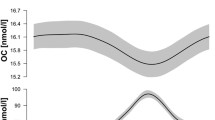Abstract
Osteocalcin is an osteoblast-specific protein believed to be associated with events occurring during bone mineralization, which has been widely used clinically as an indicator of osteoblast function. Plasma osteocalcin concentrations (pOC) were studied in 94 (59 male, 35 female) healthy and 44 (21 male, 23 female) rachitic Nigerian children, all one to five years of age. The study was aimed at establishing a reference range for healthy Nigerian children determining any changes in plasma osteocalcin levels occurring in children with calcium-deficiency rickets. In the controls, pOC levels ranged from 3–89 ng/ml, with a mean value of 23±19 ng/ml. The values were higher in girls (29±21 ng/ml) than in boys (21±18 ng/ml), though not significantly. The controls had values consistent with other published pediatric ranges from Europe and North America. In the younger rachitic children (under 3 years) the mean pOC was lower than in the controls (P=0.04) despite the much elevated plasma levels of 1,25(OH)2D. In the controls, pOC correlated with 1,25(OH)2D (r=0.59, P=0.003), alkaline phosphatase (r=0.22, P=0.03), and inorganic phosphate (r=0.27, P=0.01). These correlations were lost in the rickets group. The findings in the controls confirm the known association between plasma 1,25(OH)2D and circulating osteocalcin levels, whereas the findings in the rickets group suggest that the stimulatory effects of 1,25(OH)2D on osteocalcin may depend on other permissive factors, such as normal circulating levels of calcium and phosphate.
Similar content being viewed by others
Abbreviations
- pOC:
-
Plasma osteocalcin
- Ca:
-
albumin-corrected calcium
- PO4 :
-
morganic phosphate
- ALKP:
-
alkaline phosphatase
- 25(OH)D:
-
25hydroxyvitamin D
- 1,25(OH)2D:
-
1,25 dihydroxyvitamin D
- iPTH:
-
intact parathyroid hormone
References
Lian JB, Gundberg CM (1988) Osteocalcin: biochemical considerations and clinical applications. Clin Orthop Rel Res 226: 267–291
Price PA, Williamson MK, Lothringer JW (1981) Origin of vitamin K-dependent protein found in plasma and its clearance by kidney and bone. J Biol Chem 256:12760–12766
Okonofua F, Gill DS, Alabi ZO, Thomas M, Bell JL, Dandona P (1991) Rickets in Nigerian children: a consequence of calcium malnutrition. Metabolism 40:209–213
Oginni LM, Worsfold M, Oyelami OA, Sharp CA, Powell DE, Davie MWJ (1996) Aetiology of rickets in Nigerian children. J Pediatr 128:692–694
Pettifor JM (1994) Privational rickets: a modern perspective. J Roy Soc Med 87:723–725
Greig F, Casas J, Castells S (1989) Plasma osteocalcin before and during treatment of various forms of rickets. J Pediatr 114:820–823
Gundberg CM, Cole DEC, Lian JB, Reade TM, Gallop PM (1983) Serum osteocalcin in the treatment of inherited rickets with 1,25-dihydroxyvitamin D3. J Clin Endocrinol Metab 56: 1063–1067
Gundberg CM, Grant FD, Conlin PR, Chen CJ, Brown EM, Johnson PJ, LeBoff MS (1991) Acute changes in serum osteocalcin during induced hypocalcaemia in humans. J Clin Endocrinol Metab 72:438–443
Lian JB, Carnes DL, Glimcher MJ (1987) bone and serum concentrations of osteocalcin as a function of 1,25-dihydroxyvitamin D3 circulating levels in bone disorders in rats. Endocrinol 120:2123–2130
Scariano JK, Walter EA, Glew RH, Hollis BW, Henry A, Ocheke I, Isichei CO (1995) Serum levels of the pyridinoline crosslinked carboxyterminal telopeptide of type I collagen (ICTP) and osteocalcin in rachitic children in Nigeria. Clin Biochem 28:541–545
Pettifor JM, Ross FP, Travers R, Glorieux FH, DeLuca HF (1981) Dietary calcium deficiency: a syndrome associated with bone deformities and elevated serum 1,25dihydroxyvitamin D concentration. Metab Bone Dis Rel Res 2:301–305
Worsfold M, Sharp CA, Davie MWJ (1988) Serum osteocalcin and other indices of bone formation: an 8-decade population study in healthy men and women. Clin Chim Acta 178: 225–235
Power MJ, Fottrell PF (1991) Osteocalcin: diagnostic methods and clinical applications. Crit Rev Clin Lab Sci 28:287–335
Garnero P, Grimaux M, Seguin P, Delmas PD (1994) Characterization of immunoreactive forms of human osteocalcin generated in vivo and in vitro. J Bone Min Res 9:255–264
Gundberg CM, Lian JB, Gallop PM (1983) Measurements of γ-carboxyglutamate and circulating osteocalcin in normal children and adults. Clin Chim Acta 128:1–8
Kruse K, Kracht U (1986) Evaluation of serum osteocalcin as an index of altered bone metabolism. Eur Journal Pediatr 145: 27–33
Cole DEC, Carpenter TO, Gundberg CM (1985) Serum osteocalcin levels in children with metabolic bone disease. J Pediatr 106:770–776
Luk'ianova EM, Antipkin IuG, Omel'chenko LI, Iakovlev AA, Makeev SM (1990) Osteocalcin in infants with rickets [Russian]. Pediatriia 1:36–40
Author information
Authors and Affiliations
Additional information
Correspondence to: L. M. Oginni at the Charles Salt Research Centre
Rights and permissions
About this article
Cite this article
Oginni, L.M., Worsfold, M., Sharp, C.A. et al. Plasma osteocalcin in healthy Nigerian children and in children with calcium-deficiency rickets. Calcif Tissue Int 59, 424–427 (1996). https://doi.org/10.1007/BF00369204
Received:
Accepted:
Issue Date:
DOI: https://doi.org/10.1007/BF00369204




